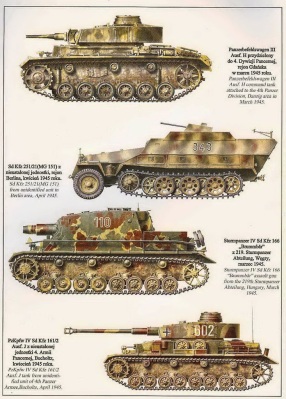The motorized divisions were effectively the elite of the German infantry. In 1942-43 the 14,319-strong M1940 Motorized Divisions, with two motorized infantry regiments and motorized divisional support units and services, each received a Panzer and an anti-aircraft or assault gun battalion. On 23 June 1943 they were redesignated M1944 Armoured Infantry Divisions (singular: Panzergrenadierdivision), 14,738 strong with two motorized armoured infantry regiments (each 3,107 men) and one Panzer battalion (602 men and 52 tanks); seven divisional support units – one motorized artillery regiment (1,580 men), and field replacement (973 men), armoured reconnaissance (1,005 men), anti-tank (475 men), motorized anti-aircraft (635 men), motorized engineer (835 men) and motorized signals (427 men) battalions; plus 1,729-strong divisional services.
The Panzer divisions steadily lost effectiveness as their strength and weaponry declined. On 24 September 1943 all 15,600-strong M1941 Panzer Divisions were reorganized as M1944 Panzer Divisions. Each had an establishment of 14,013 German troops and 714 Hilfswillige, in a two-battalion Panzer regiment (2,006 men, 165 tanks), a 2,287-strong armoured infantry regiment (one battalion on half-tracks), and a 2,219 motorized armoured infantry regiment; divisional support units were an armoured artillery regiment (1,451 men), and armoured field replacement (973 men), anti-aircraft (635 men), armoured reconnaissance (945 men), armoured anti-tank (475 men), armoured engineer (874 men) and armoured signals (463 men) battalions; 1,979 personnel provided additional divisional services.
On 24 March 1945 all armoured divisions were ordered to be reorganized as 11,422-strong M1945 Panzer Divisions, with a mixed 1,361-strong Panzer regiment with one Panzer (767 men and 52 tanks) and one half-track-mounted armoured infantry (488 men) battalion, two motorized armoured infantry regiments (each 1,918 men), and support units and services as before.
